Anurai
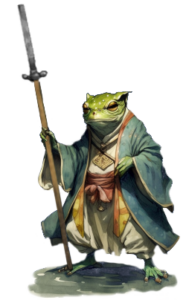
Appearance:
Built:
From fit to muscular.
Height:
Females: 190-195
Males: 195-205
Weight:
Females: 60-75
Males: 70-95
Lifespan:
Females; 120-145
Males: 145-155
Skin:
Shades of green, some brown.
Hair:
None.
Eyes:
Any
Language:
Culture:
- NOBILITY
- URBAN
Anurai characters
- Zaarook 'Swiftfoot' Krullan
- Lirraa 'Mistgaze' Yunagu
- Raakkarr 'Stoneshield' Defees
- Miooraa 'Sunleap' Vangul
- Drraak 'Thornclaw' Ghanmul
Bufoi Characters
- Khroghar 'Tounguelash' Shybir
- Thurhog 'the Fist' Choltar
- Zhilhara 'Hearthripper' Tholsty
Legend
“Only the Divine Races can jump like the Anurai, making them easily defeat cavalry and palisades.”
Description
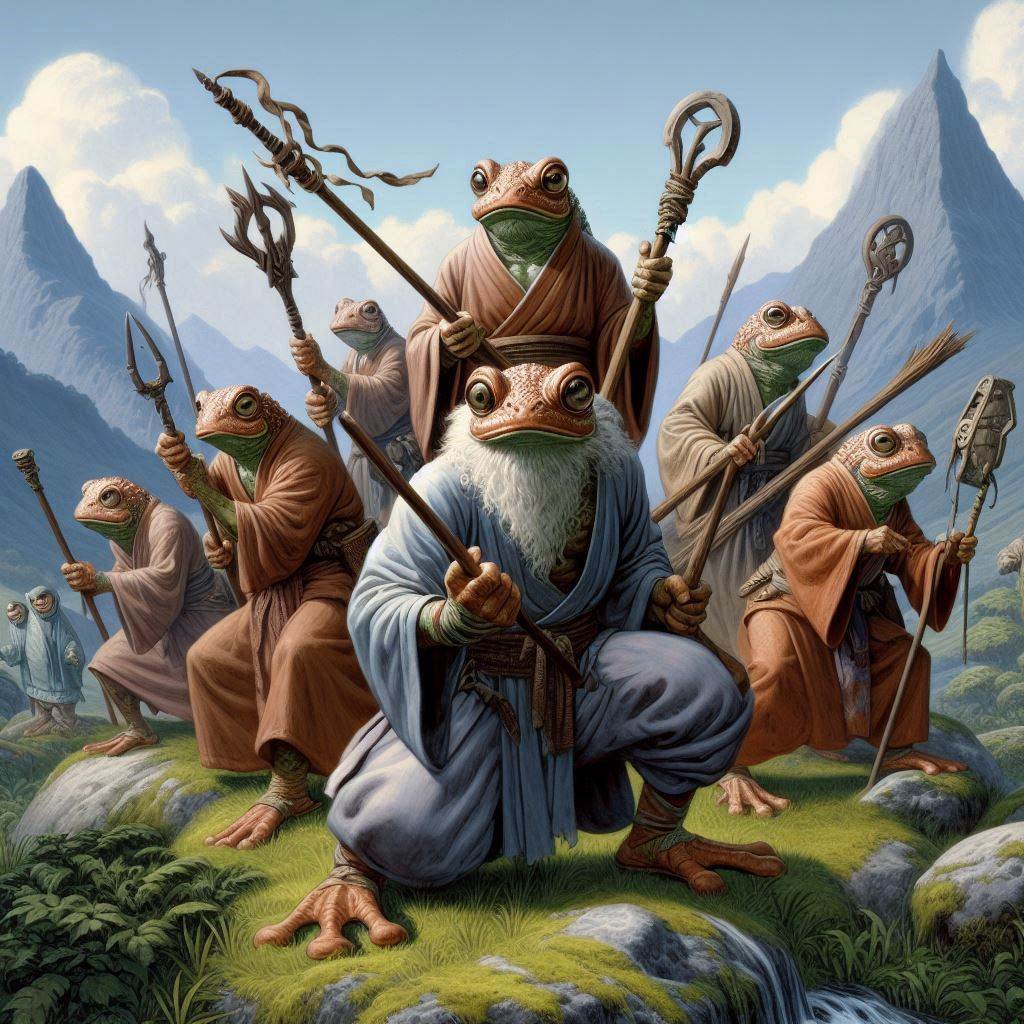
Anurai have moist glandular, brown, green, and grey skins with dapples, often non-toxic; however, bright red, yellow, and black skins with patterns are generally poisonous. Their frog-like features include large, bulging eyes, stocky bodies, short spines, long legs, lengthened ankles, lengthy feet, and webbed feet with three to five toes. Their arms are slender but muscular, and their hands have three fingers and one thumb, concealing pointy bones that can dart out like claw-like endings.
Some of the Anurai are either exceptionally large or strong; a few have beards; and some have hair down their sides and thighs. Most often, these extraordinary Anurai fill the roles of unit leaders or as regiment-inspiring champions, being followed and obeyed regardless of Anurai’s clan origin.
Also, among the Anurai live some rather bloated ones, reminding more of toads, with dry, warty skin, called Bufoi. Being less agile but physically stronger and closer to the deities, these possess both of the Anurai’s coveted characteristics and are adept at mana manipulation. Which distinguishes them as blessed by their creator deity and naturally lifts them to positions of power.
They are all as good as ever, clad in fabric robes dyed in varied hues of a single colour or with elaborate coloured patterns. They typically wield polearm weapons and, at times, carry daggers, pouches, flasks, and tools. They are highly aggressive and rash, and they are known for taking prisoners and using them as slaves for hard tasks.
Skjald Vinotis
History
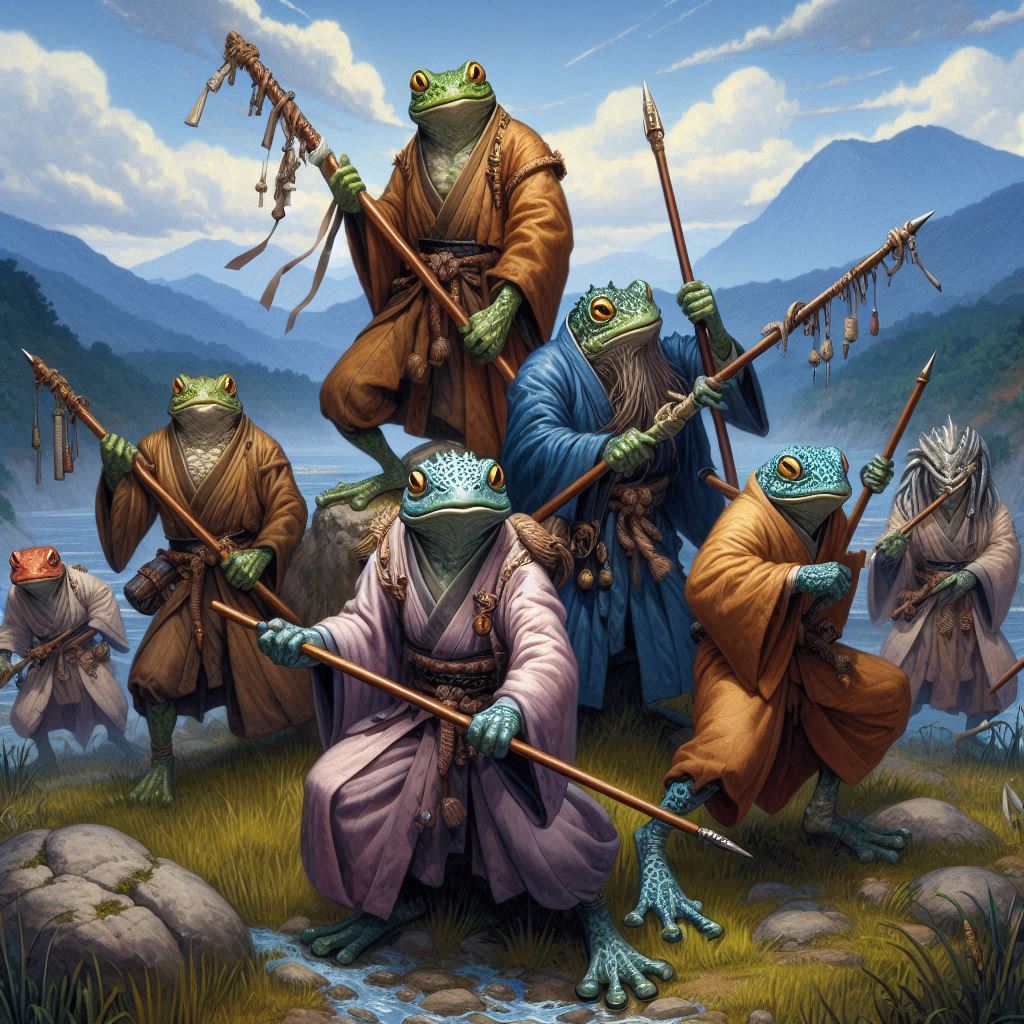
Dark Ages
According to Anurai tales, they were made by an ancient deity who shaped them from the swampy edges of the void gardens. This deity bestowed upon them agility, strength, and the ability to mentally traverse the astral world, empowering them to protect the mysteries and magical legacy of what would later become the Outlands‘.
We know very little about their origins; thus, Anurai is a mystery to us. We also know very little about their homes in the Outlands, other than what the skjald Yell'a'Beard told us and what we learned from those we captured as prisoners of war.
Skjald Valgrif
First Age
Outlands were established from marshy borders and swampy centres of void gardens. Thus, they were mysterious, dense swamps or marshlands, teeming with magical plants and wildlife. These areas were full of old, powerful ley lines, which the Anurai and Bufoi tapped for their mana manipulating, engaging in spiritual journeys, and astral travel. The outlands quickly became littered with sacred sites and monastery structures erected along these ley lines.
These were the locations where the Anurai and Bufoi performed their trance rituals, manipulated mana, and received visions. These places are often concealed or protected by powerful enchantments, making it difficult for outsiders to find or enter. Sometimes, however, we know they met with Archaic and N-Erectus, especially if astral locations collided with Anurai temples.
Skjald El Mary
Second Age
The 1st Cataclysm, had an odd impact on their race, as every egg, unhatched during the tilt, produced infants with four toes. No other difference, Anurai and Bufoi continued to live relatively secluded in the Outlands. Their monastic society was focused on spiritual growth, the study of ancient magic, and the maintenance of balance within their homeland. They occasionally conducted raids or engaged in conflicts with neighbouring tribes and races, but those were minor and aimed at protecting their territory, resources, and knowledge. As well as their delicious food recipes—the only good thing about them.
Skjald Yell'a'Beard
Third Age
Seemingly around the beginning, or early in the third age, a hidden Anurai temple was uncovered. It had an old prophecy inscribed on its walls that told of a day when the balance of power would be disturbed. Mentioning a future with a large migration and a decisive struggle, it introduced a new age headed by individuals who had hitherto been consigned to the spiritual and home realms. And then they felt the world tilt and ley lines exhaust.
From various prisoners of war, we have learned some about why they came. Long ago, a bull-headed man, an ancient enemy, returned and stirred their lands. But the results of the Vular War—the Ljostaris sinking, the Mt. Vulas eruption, and the Deep Blue Tsunami—seemingly also affected the Outlands, although they don’t, like us, count it as the beginning of an age.
Skjald Sigurd
Fourth Age
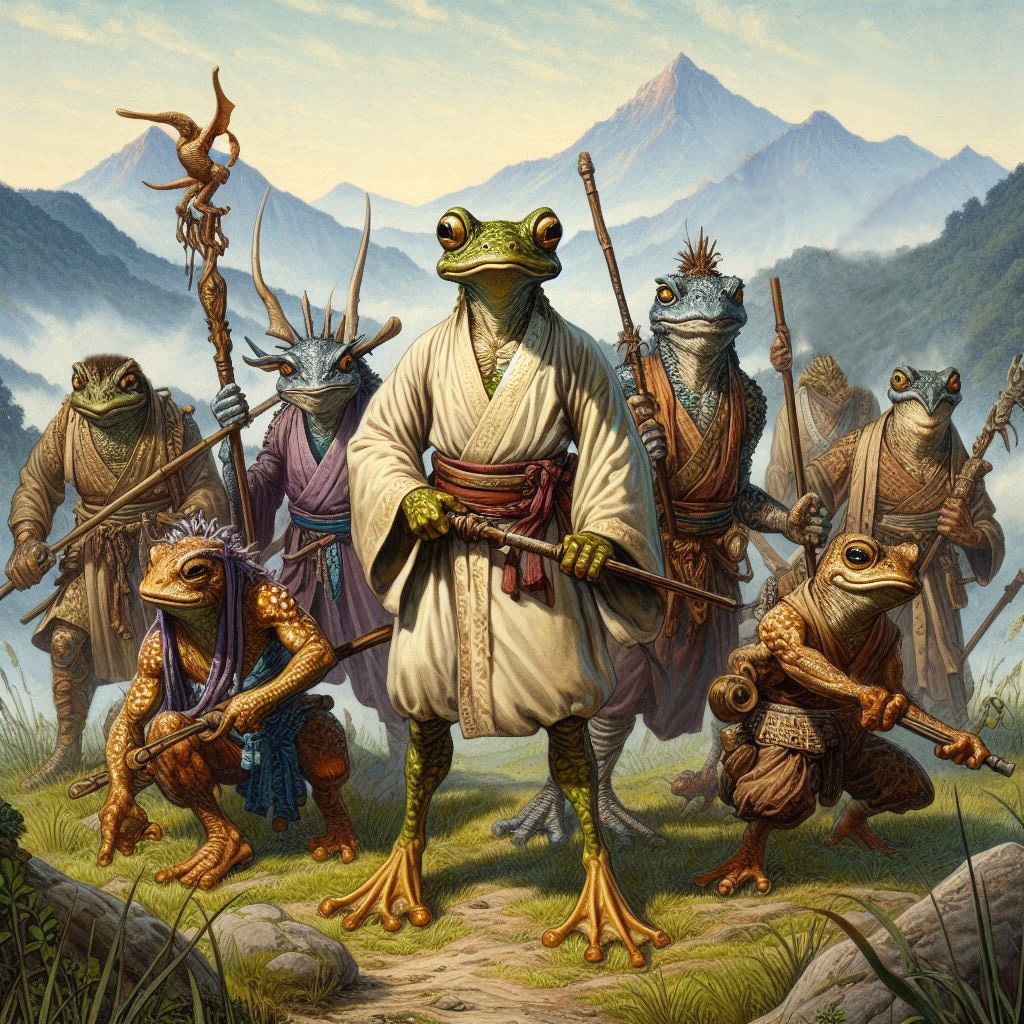
The significant ecological disaster resulted in a shift in the ley lines’ power, disrupting astral travel, magic paths, and their spirit-walking on the astral. The tainted waters also created some Arisen Romasai, making the Outlands less hospitable. This triggered their ancient prophecy and a series of visions of great changes in their destiny, awaiting them beyond their traditional borders.
Once more, a world tilting once more had an odd impact on their race. As with the 1st Cataclysm, every egg, unhatched during the disaster, produced infants with five toes. As they knew, the three and four toed, was different in no other way. They had just shrugged and lived on, seeing all three branches thrive and multiply.
Skjald Vinotis
As the prophecy began to unfold, anurai females, long involved in spiritual practices and their society’s maintenance, sensed the impending changes. Female seers and shamans like Lira Mistgaze received powerful visions. A charismatic and visionary Bufoi leader also emerged, High Priestess Zharah’la, who used the situation as a call for the females to seize power.
The female Anurai started organising secret gatherings, discussing the need for change and the interpretation of the prophecy. Although held in their sacred sites, these meetings were kept away from the eyes of the male-dominated warrior class. But males, led by figures like War Chief Zaarook 'Swiftfoot' Krullan and General Thurhog, saw them as a threat to their traditional roles and power structures.
This led to internal strife and a power struggle within their society, resulting in a significant shift in Anurai culture. The females took on more prominent roles in decision-making and governance. The males, while initially resistant, gradually accepted this new structure, especially as the females were backed by some powerful Bufoi males.
Amidst this turmoil, the old prophecy was interpreted to mean that the Anurai must expand beyond the Outlands. Such a migration was seen both as a way to seek new lands and as an escape from internal conflicts. And in 1277, many of the males embarked on what became the great invasion. While the females stayed behind, consolidating their power and continuing the spiritual guardianship of their homeland,.
Skjald Ulrich
High Priestess Zharah’la, Leader of the Uprising
Zara’la has black skin with intricate golden patterns and eyes that burn with determination. Her presence is commanding and serene, embodying the prophecy’s power.
Zharah’la rallied the females by interpreting the ancient prophecy, leading them to demand a greater role in their society. Her spiritual insight and leadership skills make her a pivotal figure in the uprising.
Liharah Mistgaze Hyisno, Seer and Spiritual Advisor
Liharah, with her smooth blue-green skin and large, dark eyes, continues to guide her people with visions. She becomes a close advisor to Zharah’la and helps navigate the spiritual aspects of the uprising.
Liharah’s visions confirmed the need for change, and she used her influence to support the uprising, helping to unify the Anurai and Bufoi females in their quest for equality.
Mihroaah Sunleap Aburi, Alchemist for the Uprising
Mihroaah’s light green skin and agile build make her ideal for her role. She is swift and resourceful, using her skills to gather intelligence and support the uprising’s coordination.
Mihroaah’s quick movements and ability to stay unseen were crucial in delivering messages and organising secret meetings, making her an invaluable asset to the cause.
Skjald Valgrif
However, in 1277, they surprisingly attacked The Realm, naturally choosing to bring their well-organised monastic life from the Outlands to here. Their first targets were big castles and monasteries, and despite the fact that the Great Invasion and the Cleansing Crusade are over, a couple of these locations remain under siege; in any case, they will not jump anywhere now.
As prisoners of war, we have heard that the internal conflict didn’t end entirely with the migration. Those left behind, both males and females, continue to struggle for dominance. However, the prophecy suggested a long-term transformation, leading to a society where spiritual and physical strengths were equally valued.
Skjald Sejrik
Cartography
On Markeöy and Naldar isles… in besieged locations… linger besieged tribes.
Skjald Kazumix
Organisation
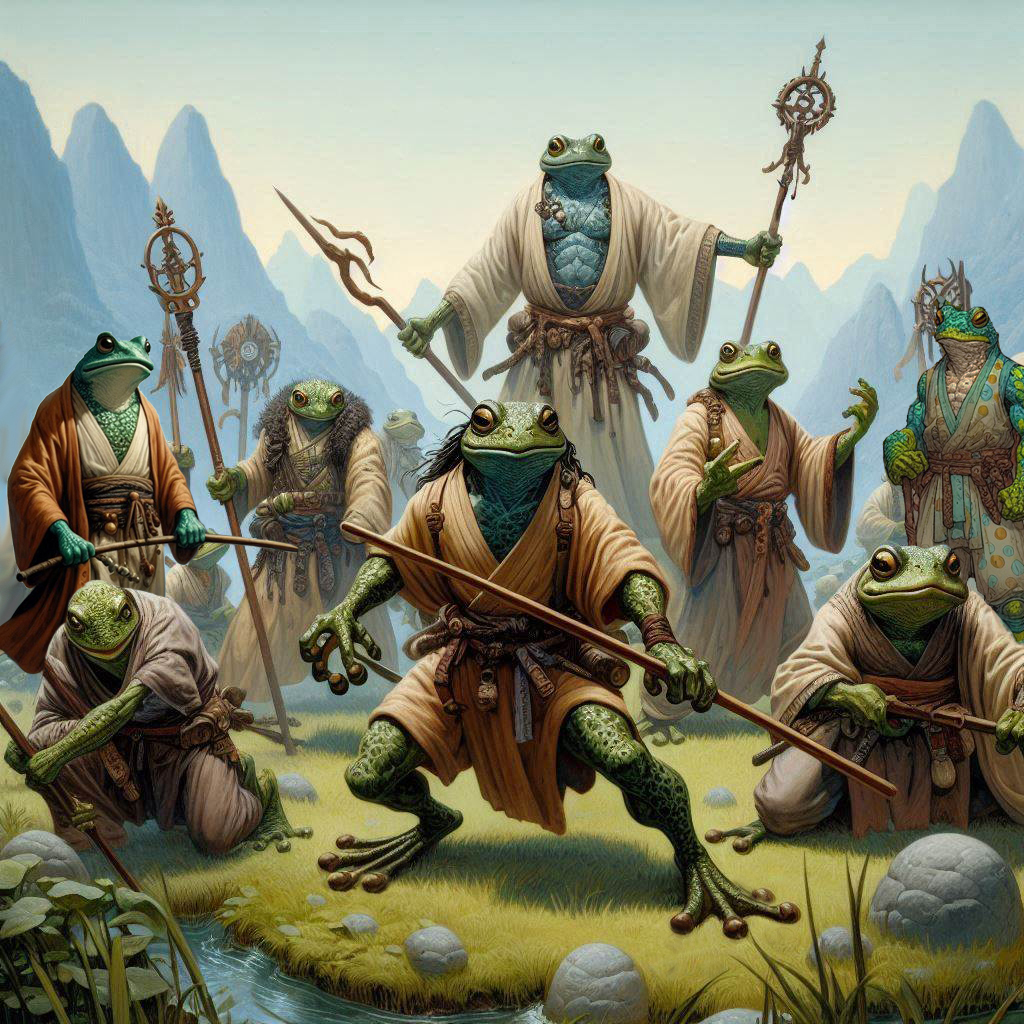
Their leaders are as far above their warriors and workers as the nobles of any human tribe. They are only loyal to their tribe’s senior leaders, or the special ones assigned to them by their war- counsel.
Males are primarily warriors and explorers, while females are more active in spiritual and household issues.
The females have remained in the Outlands to protect and maintain holy locations as well as to continue their spiritual activities, therefore ensuring the cultural and magical heritage is preserved.
Skjald Vinotis
They are apparently classified into three types:
Anurai make up the majority of what we’ve seen, appearing to form their warrior and, to some extent, worker class when there are no slaves available.
Bufoi are luckily extremely rare; as powerful mana manipulators, they don’t lead but rather support their groups and contingents.
Very large Anurai and Bufoi, or individuals with beards or hair down their sides and tighs, are at times seen taking on the role of leaders in battle.
Skjald Sigurd
Outstanding Anurai Characters
Zaarook 'Swiftfoot' Krullan, War Chief
With a light, muscular build and green-dappled skin, Zaarook is renowned for his unparalleled agility and combat prowess. His piercing yellow eyes are always scanning for threats. He wields a long spear with deadly precision.
Zaarook led the first wave of the invasion in 1277. His tactical genius and ability to rally the Anurai made him a legendary figure among his people. He is fiercely protective of his tribe and has a deep hatred for the human defenders who resist their occupation.
He was charismatic, strategic, and fiercely loyal to his tribe. He has a quick temper.
Lirraa 'Mistgaze' Yunagu, Seer and Shaman
Lirraa has smooth, moist blue-green skin and large, dark eyes that seem to peer into the soul. He carries a staff adorned with charms and runes, and his movements are graceful and deliberate.
Gifted with the ability to walk on the astral plane, Lirraa has guided his people with visions and prophecies. His wisdom and foresight have saved the Anurai from numerous dangers.
Calm, serene, and deeply spiritual. He speaks in riddles and often seems detached from the physical world, but his insights are invaluable.
Raakkarr 'Stoneshield' Defees, Warrior
With broad shoulders and dark, mottled skin, Raakkarr is a formidable presence. His clawless hands are strong, and he often wields a large, spiked club. His eyes are a steely grey.
Tasked with protecting the ancient temples and sacred sites in the Outlands, Raakkarr has fought off countless intruders. His dedication to preserving the Anurai’s heritage is unwavering.
Stoic, disciplined, and unyielding. He has little patience for those who threaten his people’s way of life but is deeply respectful of Anurai traditions and elders.
Miooraa 'Sunleap' Vangul, Messenger
Miooraa has light green, almost yellow skin with a sleek, agile build. His eyes are bright and alert. He carries a small dagger and a pouch of herbs and tools for survival.
Known for his speed and stealth, Miooraa traverses great distances to deliver messages and gather intelligence. His skills have been crucial in outmanoeuvring enemies and securing alliances.
Energetic, curious, and resourceful. He has a keen sense of humour and is always eager to explore new territories.
Drraak 'Thornclaw' Ghanmul, Slave Overseer
Drraak’s skin is a dark, muddy brown, and his physique is imposing. His eyes are sharp and calculating. He wields a cruel whip and carries a short sword.
Responsible for managing the slaves captured during raids, Draak is known for his ruthlessness and efficiency. He ensures that the Anurai’s labour needs are met, often pushing slaves to their limits.
Harsh, demanding, and intimidating. He commands respect through fear and is utterly loyal to the Anurai cause.
Outstanding Bufoi Characters
Khroghar 'Tounguelash' Shybir, Grand Sage and Spiritual Leader
Khroghar has dry, warty skin of a deep red hue, and his eyes glow with an inner light. He is physically larger than most Anurai, exuding an aura of power and wisdom. He carries a staff imbued with magical energy.
As the most powerful mana manipulator among the Bufoi, Khroghar leads the spiritual and magical practices of his people. His visions have guided major decisions and migrations.
She is wise, contemplative, and deeply respected. Khroghar speaks with authority and is considered almost a living conduit to the ancestral spirits.
Thurhog 'the Fist' Choltar, General
Thurhog’s skin is a mottled mix of yellow and black, indicating his toxic nature. His body is muscular and imposing. He wears armour crafted from enchanted materials and wields a massive warhammer.
Thurhog is one of the few Bufoi to take an active role in combat. His strength and magical prowess make him a terrifying opponent on the battlefield. He played a key role in organising the initial invasion forces.
Fierce, disciplined, and strategic. Thurhog demands absolute loyalty and is known for his brutal efficiency in battle.
Zhilhara 'Hearthripper' Tholsty, High Priest and Sage
Zhilhara has black skin with bright yellow patterns, signifying his high toxicity. His eyes are a mesmerising violet. He wears elaborate robes and carries a ceremonial dagger.
As the High Priest, Zhilhara oversees the rituals and ceremonies at the sacred sites. His deep connection to the spiritual realm allows him to perform powerful enchantments and blessings.
Devout, enigmatic, and authoritative. Zhilhara’s presence commands respect and awe, and he is known for his unwavering faith and dedication to the Bufoi’s spiritual traditions.
Skjald Vinotis
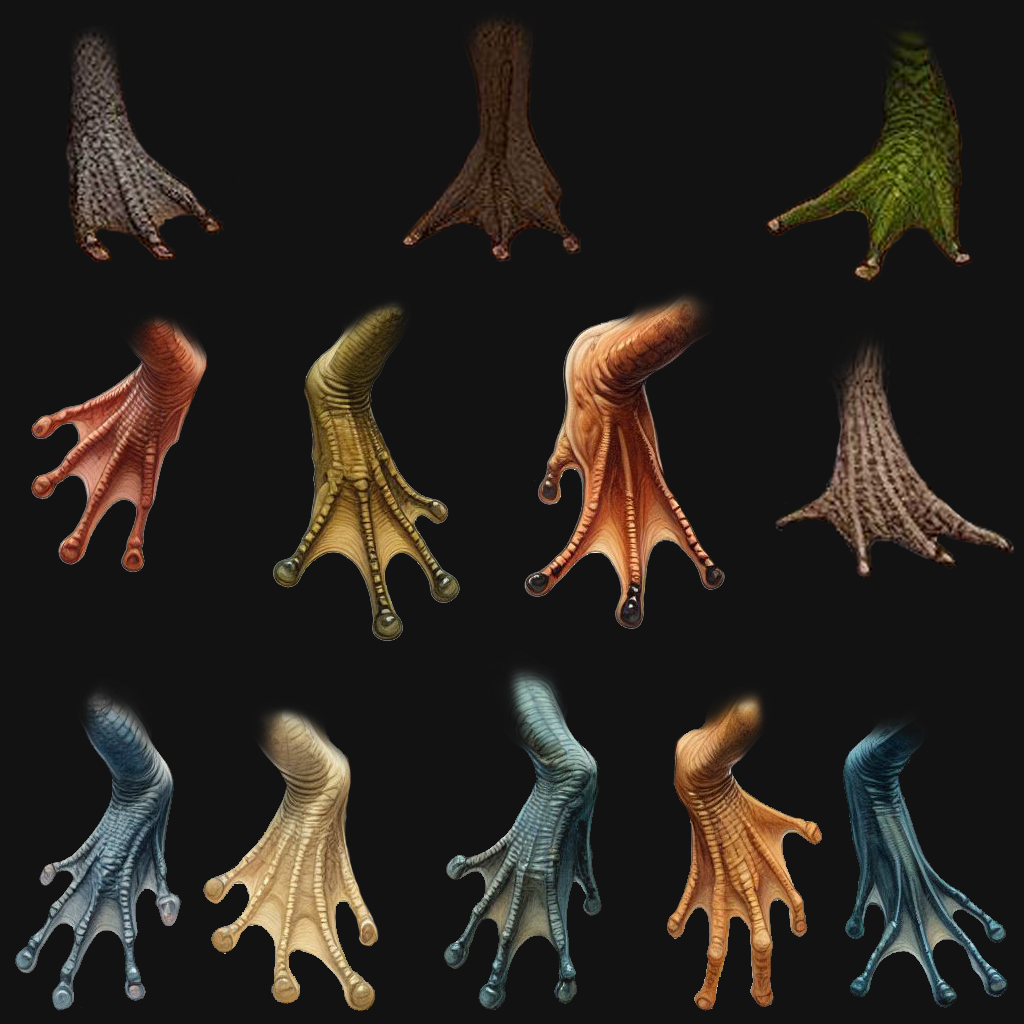
Anurai, from three to five toes:
As ley lines were disrupted by world disasters, it affected the magical essence that shapes the Anurai during embryonic development.
Seemingly, the tilting of the world subtly altered the Anurai’s habitat, requiring them to navigate new terrain and environments. More toes were a physical locomotion adaptation for better climbing, gripping, and swimming, as they provided better balance and agility.
The increase in the number of toes was not only an advantageous adaptive mutation triggered by the magical changes. Each toe increase also symbolises a stage in their destiny, as per the Anurai prophecy. The Anurai view these changes with mixed feelings; some see them as blessings, others as curses, and some see them simply as a quirk of fate.
Some Anurai think that the changing number of toes represents a shift in their identity or purpose. So, they are evolving into a new race, and the additional toes are a physical manifestation of this change. Thus, the fewer toes, the lower social status it has, although their battle proves or magical abilities easily lift them upwards.
As we walked into the scorched dawn, Anurai saw no further toe-increases. But this was also a mortal war, so they still wonder: will the toe count continue to increase with future cataclysms? Is there a limit?
Skjald Sejrik
Special
They have the ability to let their spirits walk the astral plane when in trance, thus being able to see ‘visions’ that might come true.
Skjald Valgrif
Last Updated on 2024-06-13 by IoM-Christian
